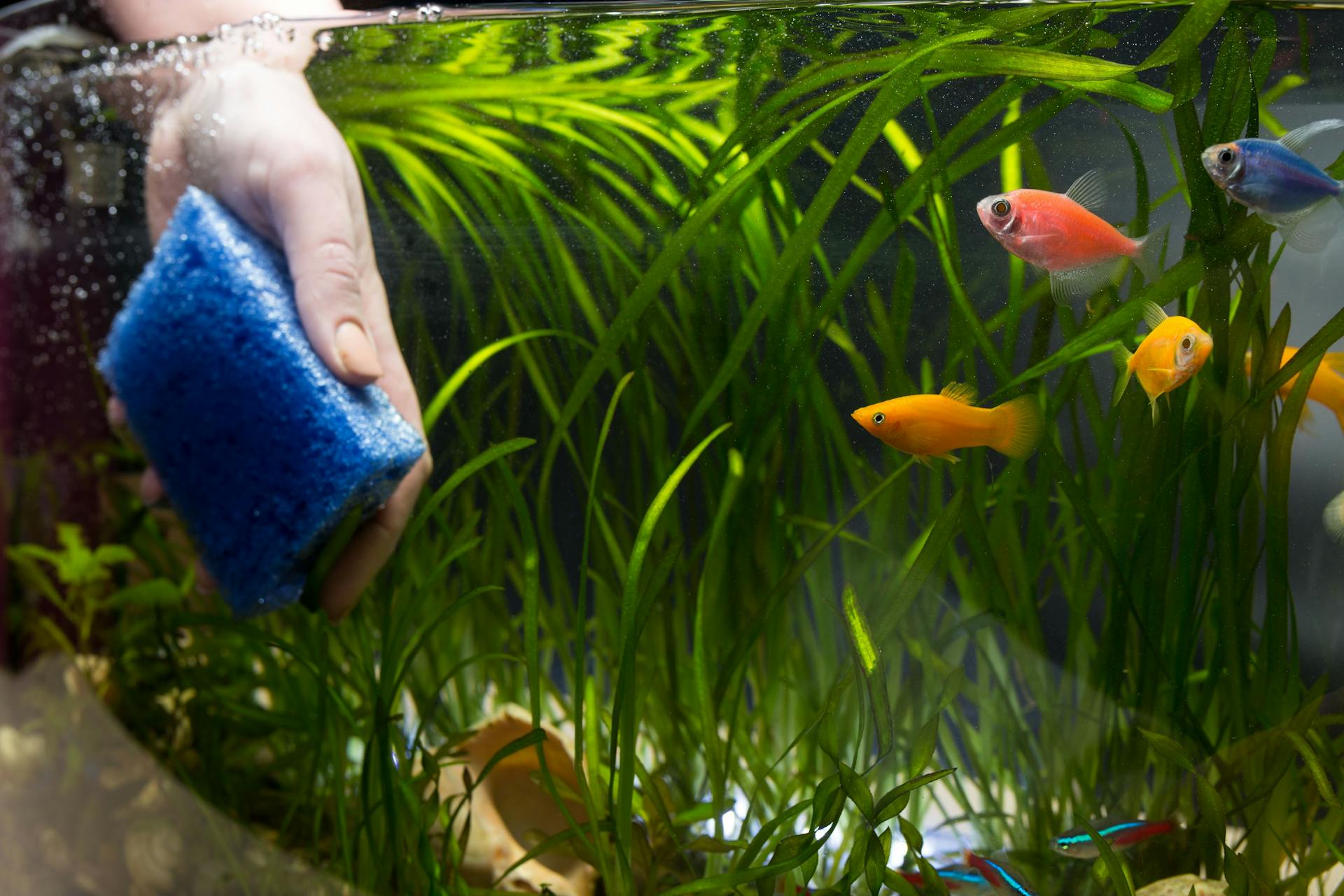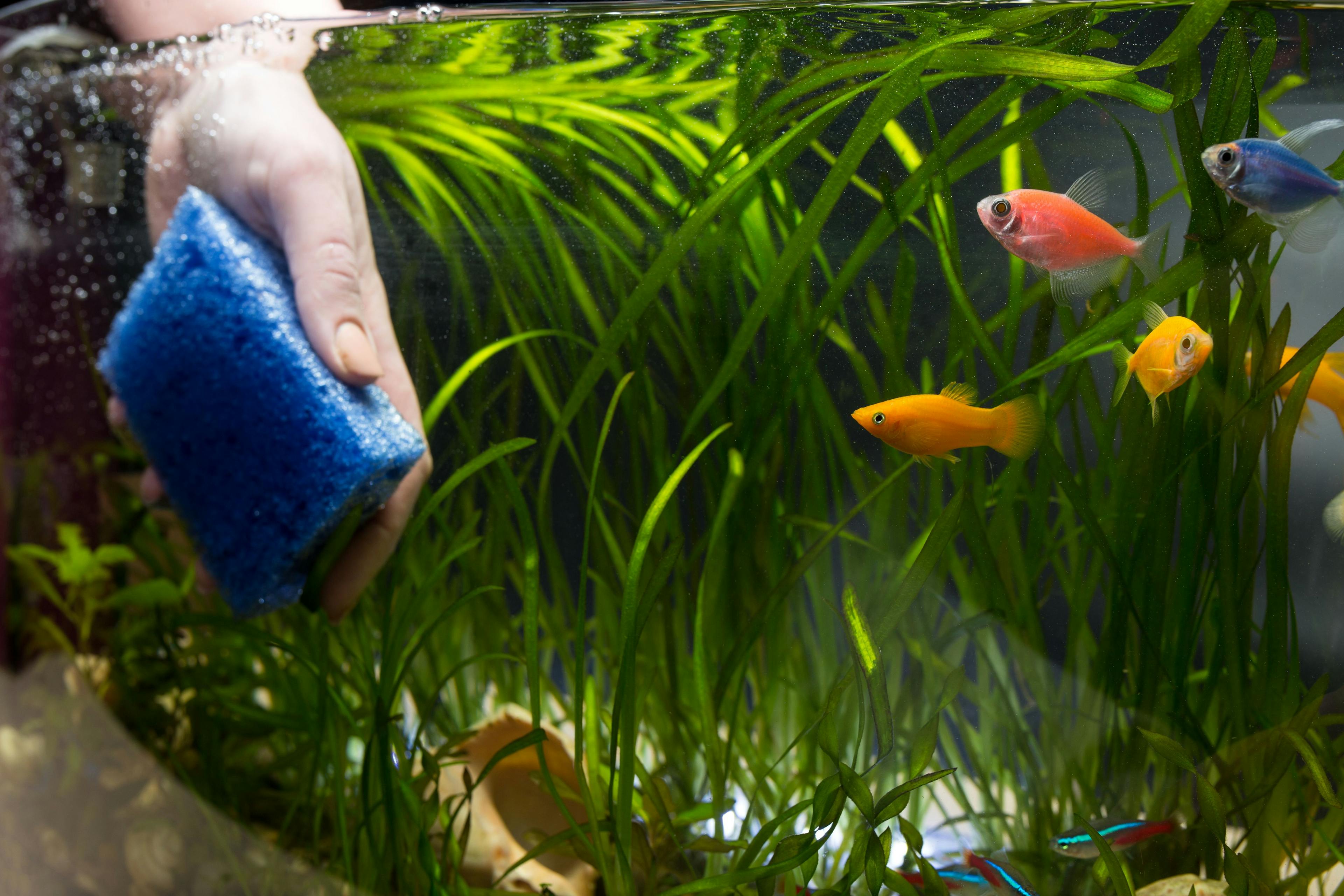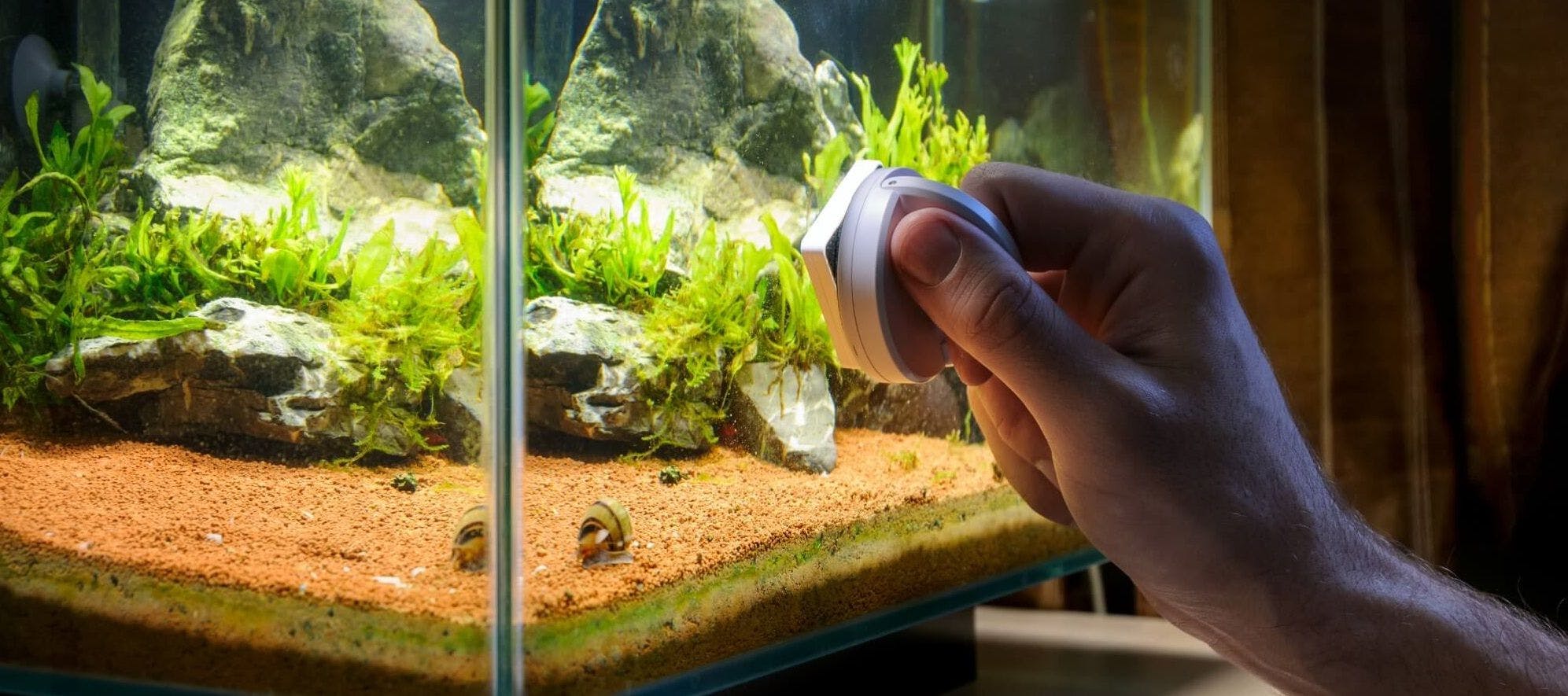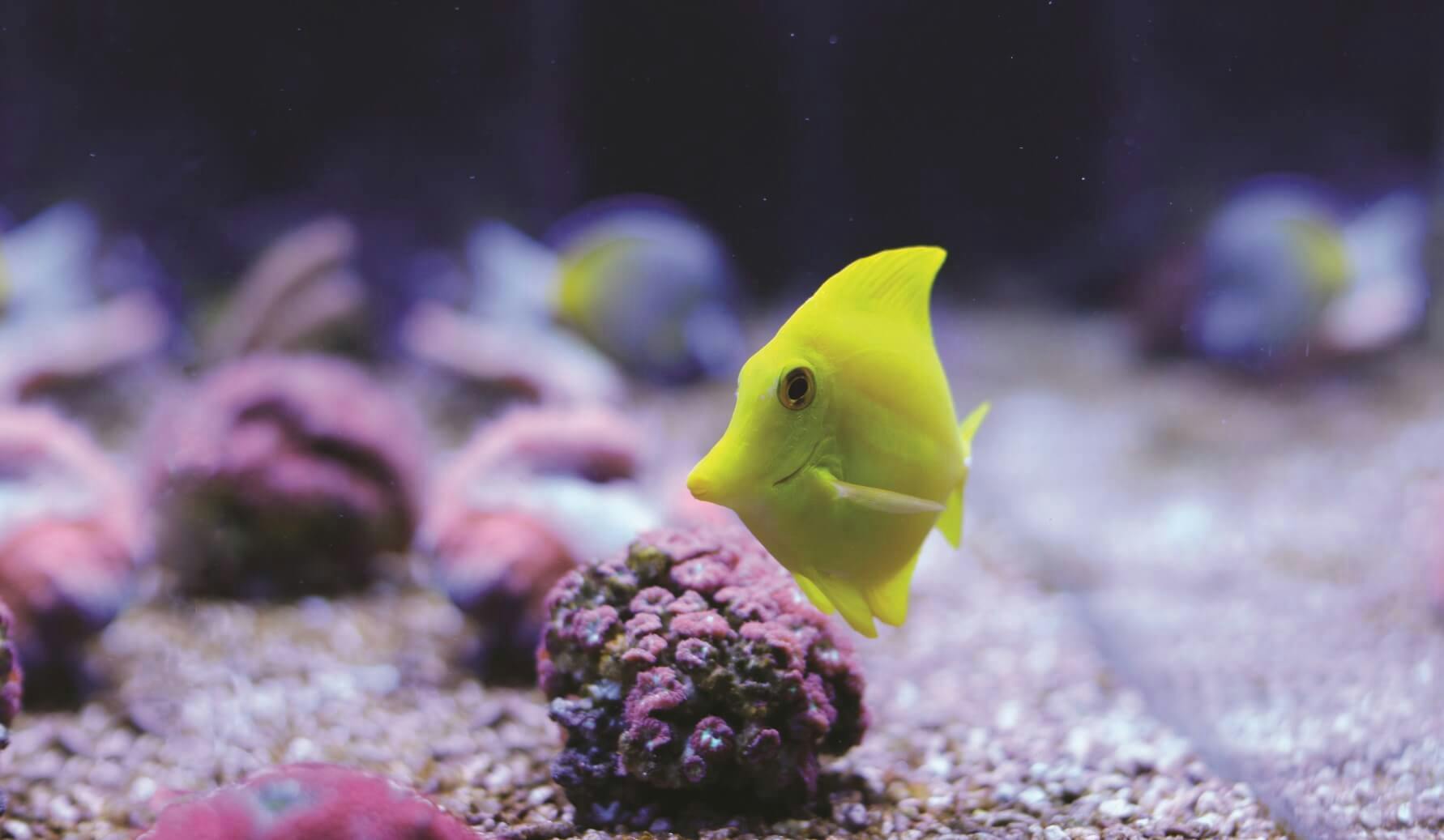

To keep your fish happy and healthy, you will need to perform a few regular maintenance jobs. This includes a partial water change and water testing. Fish, like every other pet, require love, commitment and care. Part of keeping your fish happy and healthy is cleaning your fish tank on a regular basis, which includes partial water changes and water testing — all which are easy to do at home, or with the help of a PETstock team member.
The steps on cleaning a fish tank
Cleaning a fish tank only takes a few steps – it just needs to be done on a regular basis! Every day your fish is swimming around in an enclosed ecosystem, where waste can quickly build up and turn toxic, if not properly cleaned. A smaller tank will build up waste at a faster rate than a larger tank. As will tanks with a large fish population.To make sure your fish stay healthy, it is recommended that you conduct a water change every two weeks (this is a guide and may be needed more or less, depending on your tank). This can be done in the form of a water change, where water is removed from the tank and is replaced with fresh tap water (will need to be treated with water conditioner), or through a gravel vacuum (where excess wastes stored in the gravel are removed). This also removes water. It is recommended that a gravel clean in conducted every fortnight. This can vary depending on the size of the tank, and the size of your fish population.
What you'll need:
- A large bucket (or similar)
- A towel - just in case of any spills!
- A gravel vacuum
- Water conditioner and treatment
What you need to do:
- Firstly, don’t take your fish out of the tank. Taking your fish out of the tank while you clean can really stress them out – and it’s not necessary, because you can work around them!
- Use a gravel vacuum and bucket. A gravel vacuum is a plastic tube (generally about 2 inches in diameter) attached to a siphon tube, used to remove waste and water from tank gravel into a bucket. A gravel vacuum operates by churning the gravel around in a column of moving water to loosen and carry off any debris trapped in the gravel.
- Move vacuum through water evenly. While the water is siphoning through the gravel vacuum, move the end that is inside of the tank all through your gravel. Keep doing this until you have removed about 25% of the tank’s water capacity.
If you have a tropical tank, be careful not to drop the water level as low as the heater, as having your heater switched on and out of water will cause damage and compromise its efficiency.
Tip
Only ever change about 25-30% of the water in your tank. Removing any more will affect the biological filter. In other words; it would be like starting the set-up of your tank all over again. However, you may need to remove more if your fish have become ill.
- Once you have taken out your water, replace this with fresh tap water. Ensure this is completed slowly, especially in a tropical tank to ensure the temperature does not change too much.
- Treat the new tank water. Generally, you will use the same treatments you added when first setting up your tank, especially ammonia, chlorine and chloramine eliminator. Speak to your local PETstock team about which treatments you should keep on hand at all times.
Cleaning your tank like this every 2-4 weeks is the best way to maintain a healthy tank.

Controlling algae in your fish tank
If you’ve spotted what you think is algae in your tank, don’t fret. The appearance and growth of algae in your fish tank/aquarium might be all okay and normal. It’s only when algae grows out of control and covers everything, is when it should be a concern. Cleaning a tank by wiping the inside of your tank with a sponge or similar (free of any chemicals or soaps) will remove any algae or dirt build up.
Tips on keeping algae levels in your tank to a minimum:
- Test the water regularly (Phosphate, Nitrate, Iron can cause algae blooms)
- Regularly change water
- Don’t overfeed your fish, this will cause unwanted phosphate levels
- Use high grade filters and media
- Replace media when it becomes ineffective
- Buy algae control products
- Use an algae scraper
- Treat water with API Barley Fix
- Add live plants
- Ensure your tank is out of direct sunlight
- Only have your light on for no more than eight hours per day
Tip
If you keep tropical fish, the addition of any catfish may also help to keep algae levels down as they like to consume this. If algae has become a problem in your tank, there are treatments available to help fix the problem, such as API Algaefix and Blue Planet Algae Cure.
Maintaining a fish tank filter
Making sure your fish tank filter is in prime condition will ensure the best ecosystem for your fish and a clean tank. In order to look after the filter, there are several parts that require cleaning and maintenance.
This includes:
- Carbon – change every six to eight weeks
- Filter cartridge – change every six to eight weeks (these normally contain carbon)
- Sponges – maintain every two to three months. Ensure you’re rinsing in treated water as the chemicals in tap water will kill your good bacteria on contact.
- Ceramic noodles – change every six months, ensuring enough bio-filter to sustain the tank’s system.
- Impeller and rubber diaphragms – change when broken

More on water testing
Testing your fish tank’s water, as mentioned above, is essential to a healthy tank. Over time, the water parameters will change and become unsuitable for your fish’s survival. It is recommended that you check the water parameters on a weekly basis. It’s simple, but imperative. If you get into the right routine, it won’t be forgotten.
What you’ll be testing
When you test water, you need to be testing the pH, GH, Ammonia, nitrate and nitrite. This can be done at home with a test kit or at your local PETstock store by a team member (for free!).
Ammonia: Ammonia is the main waste product from fish or uneaten food that builds in the tank. This often occurs in new tanks and is referred to as ‘new tank syndrome’. In a healthy tank, the ammonia level should non-existent or at 0.0ppm (for both saltwater and freshwater tanks). At as small as 0.25ppm, this toxicity could damage the gills of your fish.
Nitrite: As with ammonia levels, nitrate should also be at 0.00ppm. Nitrate is the toxic by product of the nitrifying process that consumes ammonia in the fish tank. High nitrate levels can be toxic to fish.
pH: This is a measure of the water acidity or alkalinity of water. The scale goes from 0-14 with 0 being acidic and 14 being alkaline. For most freshwater fish, the right level sits at about 6.8-7.5, while marine fish are best kept at 8.2-8.4.
Managing the flux of the water levels is important, as even small changes can cause issues for your new or existing fish. For a free in-store water check, simply bring a tank water sample into a PETstock store in a clean container with a lid.
Starting from scratch? Find out more about the water tank cycle.
If you find your test results to be undesirable, make sure you speak to your local PETstock team member about the best solution for you. Usually, the most common course of action is a water change or the use of pH adjusting powders.